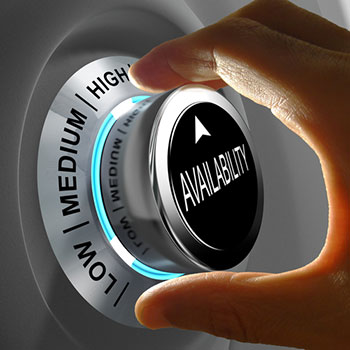Why does DRaaS matter, and how do you achieve it?
Think of the ways your business relies on IT. Manufacturing and inventory, internal and external communications, sales, delivery, marketing, purchasing, HR, supply chain and transactions of every kind – the list goes on. Add to that the IT systems that perform tasks that did not exist before automation, and it goes without saying that virtually all these are connected to the Internet.
Progress comes at a price.
Today’s IT-based business environments are not simply constantly growing collections of software and hardware products. E-proliferation has sparked the creation of new tools to manage all that technology. Chief among these is the cloud, which answers the question of what to do with the great masses of data you generate.
So far, so good, but how do you keep all your devices and systems running and interacting effectively? The cloud-enabled, interlocking technologies that accelerate, expand and improve business functions also significantly increase the risk of prolonged downtime and harmful loss of data. When even a single application goes down, the entire company takes a hit.
The more sophisticated the IT environment, the greater the potential damage to the organization. Downtime losses cannot be shrugged off as a normal cost of doing business. Sources differ as to the exact value of lost time and data, but study after study presents alarming estimates. In a recent Aberdeen Group study, for example, the direct losses to large businesses to be around $164,000 per hour, with proportionally comparable losses to smaller companies.
We tend to think of downtime losses as being a headache for major corporations only (Think the 30-minute 2013 outage that cost Amazon $2 million), but the same degree of loss can be expected for companies of any size.
Typical direct losses include temporary absence of the downed service itself as well as the potential loss of data that can cause devastating financial and legal setbacks. Because of its highly subjective nature, damage to customer relations can be equally disastrous and impossible to evaluate in advance.
The key to lowering downtime is its corollary: Disaster Recovery as a Service (DRaaS).
With the right tools and expertise, it is realistic to aim for the highest possible availability, which can cut downtime from days or hours per year to a matter of a few minutes annually.
Conventional hosting providers can offer higher availability than a company using only its internal resources, and these providers typically promise 99% availability. This sounds good at first, but one percent downtime is more than three and a half days. Bear in mind that downtimes are much more likely to occur during periods of peak activity, exactly the times when you can least afford to be unplugged that long.
You can do better than that.
DRaaS means coming as close as realistically possible to uninterrupted operations. That adds up to benefits beyond the solution of downtime problems. Let’s look at some key benefits of DRaaS.
- Cut the risk of data loss to a negligible level.
- Use data replication to strengthen your backup.
- Reduce company-wide impact during backup.
- Perform maintenance without impacting your customers.
- Raise your reputation in comparison with competitors.
- Improve your application performance.
Your ideal DRaaS approach includes a combination of products, services and best practices that promote foolproof redundancy and invincible protection of tour infrastructure. Here are some key concepts:
- Make your overall system as simple as possible. The more elements it contains, the greater the risk of failure. Learn as much as you can about each component so you can take advantage of all its features, especially those that can reduce complexity.
- Be aware that replication is not backup. In many cases, recovery is only possible through backup files, and replication preserves errors that you do not want to recover.
- Choose only scalable systems and applications throughout your company. This allows you to handle both steady growth and unanticipated spikes. Look for scalable solutions with the elasticity to evolve automatically to fit your requirements.
- Use replication and failover servers to build in all the redundancy you can afford.
- Look for ways to integrate your backup, disaster recovery and DRaaS solutions.
- Distribute loads between multiple servers. Any single-server setup invites failure and limits scalability.
- Above all, test and retest. Look at redundancies, overload potentials, and every known potential malfunction of every element.
The following to-do list is part of an implementation strategy that requires industry-leading tools and deep expertise, guided by RenovoData Consulting.
1) Data Protection: Provides peace of mind with a broad array of tools to protect and restore databases, software, email, telecoms and operating systems after systems are repaired or replaced.
- Cloud Backup
- Cloud to Cloud Backup
- Backup in a Box
- Local Disk Backup
- Private Data Vaulting
- Cloud Data Archiving
2) Server Recovery: Provides solutions such as bare metal backup, virtual machine backup and server cloning to reduce the time to rebuild Operating System Environments (OSE’s).
3) DRaaS Solutions: Customized solutions provide a “pre-built” recovery environment for organizations who cannot tolerate downtime. Use our cloud or your secondary site.
To get started, request a custom quote, contact us with your questions, or share your challenge with a RenovoData Consultant.
Please follow our company page on LinkedIn to get the latest information and news on Data Protection and Disaster Recovery.
